Understanding the Intricacies of Diamonds
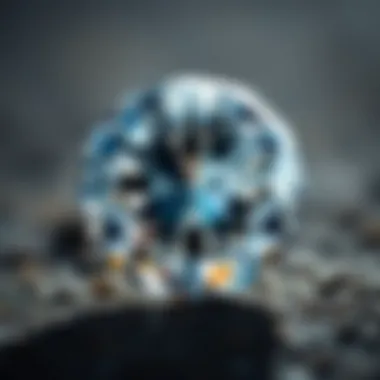
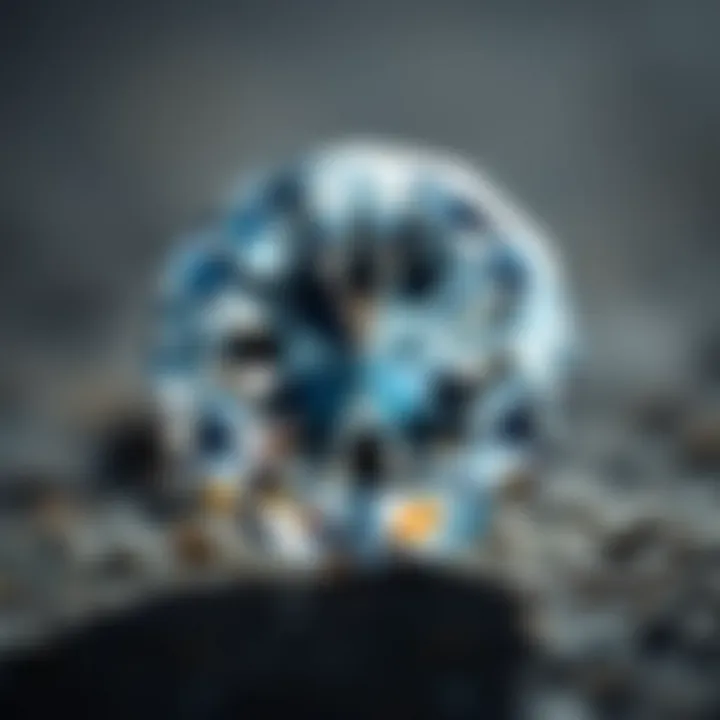
Intro
Diamonds, often regarded as the epitome of luxury, carry a weight far beyond their glimmering surfaces. While many might associate them with engagement rings or extravagant jewelry, these gemstones possess an extraordinary depth of characteristics that elevate them even above their aesthetic appeal. This exploration isn't merely about the sparkle they exude but dives into their composition, formation, and the socio-cultural narratives that shape their value.
In a world where trends come and go like the tide, diamonds stand resolutely as symbols of durability and beauty. With so many gemstones to choose from, the question begs: what is it that truly defines a diamond as a diamond? This guide aims to peel back the layers of understanding, revealing not just the geology but also the historical significance, economic worth, and cultural implications that accompany these remarkable stones.
As we embark on this journey together, we will delve into the rich history of diamonds, investigate their unique properties, and understand their place within both personal narratives and global economies. By casting a wide net across different facets of diamonds, from their origins to their social connotations, we can appreciate the gems in a fuller, more nuanced light.
History and Origins
The Birth of Diamonds
Diamonds, formed deep within the Earth’s mantle under high pressure and temperature, have a storied history. Their journey begins over a billion years ago, where carbon atoms are subjected to extreme conditions. This remarkable metamorphosis results in the creation of cubic crystal structures that are not only beautiful but notably durable. They are carried to the Earth's surface through volcanic eruptions, encased in rock formations known as kimberlites.
Overview of Collectibles, Rocks, and Fossils
For collectors, diamonds often represent the pinnacle of achievement. Much like the thrill of uncovering a fossil or a unique rock, the allure of diamonds lies in their rarity and transformation process. It’s not only about possessing these gems but understanding the geological stories they tell.
Historical Significance and Cultural Impact
From ancient India, where diamonds were first mined, to modern-day Canada, the narrative of diamonds has intertwined with human history. They have been symbols of power, love, and various ideologies. Kings wore them as talismans for protection, and today, they are often given as tokens of love. The iconic phrase "A diamond is forever" underscored their place in modern culture, forever linking them to romance and commitment.
"Diamonds have a way of bringing out the best in us, reflecting not just beauty but strength and permanence."
Identification and Classification
The Anatomy of Diamonds
When it comes to identifying diamonds, several key attributes come into play. These characteristics contribute to their overall quality and classification. With the four Cs—carat, cut, color, and clarity—each diamond tells a story of its own.
Guide to Identifying Rocks and Fossils
Identifying a true diamond can be a daunting task, especially with the variety of imitations available today. However, trained eyes can perform several tests:
- Hardness: Diamonds are rated a 10 on the Mohs scale of hardness, making them resistant to scratching.
- Refractive Index: Diamonds have a unique ability to refract light, giving them their characteristic sparkle.
- Thermal Conductivity: Diamonds dissipate heat better than other gemstones, a fact that can be tested using a thermal conductivity probe.
Common Types and Variations
Not all diamonds are created equal. They can be classified into several categories:
- Natural Diamonds: Formed over millennia in nature.
- Synthetic Diamonds: Man-made in labs but identical in structure to natural diamonds.
- Fancy Color Diamonds: These diamonds exhibit colors beyond the traditional clear variety, such as blue, yellow, or pink.
Understanding these classifications provides a clearer picture of the market and can aid collectors in making informed decisions.
Foreword to Diamonds
Diamonds are not merely brilliant gemstones but symbols woven deeply into our culture, history, and economy. Understanding their essence involves delving into what makes a diamond a diamond. This section serves as the launching pad to explore the fascinating world of diamonds, elucidating their fundamental characteristics that distinguish them from other precious stones.
The journey begins by looking at the historical significance of diamonds, which have played pivotal roles in various societies from ancient civilizations to modern times. These gems hold stories and practices that highlight their value beyond their physical beauty. Moreover, the cultural importance attributed to diamonds shapes not only our perception of them but also how they are integrated into significant life events, such as engagements and royal ceremonies.
A comprehensive understanding of diamonds requires recognizing their multifaceted identity, which can be appreciated through cultural lenses and historical narratives. This knowledge benefits enthusiasts, collectors, and anyone interested in these extraordinary stones, enabling them to appreciate not just the sparkling surface, but the depth of character diamonds embody.
Historical Significance of Diamonds
Diamonds have a rich history, often shrouded in mystique. Their earliest associations can be traced back over 2,500 years, particularly in India, where they were considered divine pieces worn by kings and warriors. During this period, diamonds were cherished not just for their beauty but also for believed protective properties. Fascinating tales highlight how they were thought to ward off evil and protect from harm, making them highly treasured in various cultures.
In Europe, the allure of diamonds surged during the Middle Ages as they became symbols of power and status. The crown jewels, adorned with exquisite diamonds, exemplified royal authority and luxury. The infamous Koh-i-Noor, one of the largest diamonds in the world, has a history that weaves through multiple kingdoms and conquests, demonstrating how diamonds have historically represented both theft and triumph.
Additionally, during the 19th century, the global diamond market underwent a transformation with the discovery of diamond fields in South Africa. This marked the beginning of the diamond boom, resulting in widespread commercialization and marketing campaigns that still resonate today. The diamond engagement ring, popularized by De Beers' ad slogan "A diamond is forever," continues to be a dominant symbol of love and commitment in many cultures.
Diamonds in Culture and Symbolism
Beyond their historical context, diamonds are steeped in cultural significance, often symbolizing love, strength, and status. In many societies, they are regarded as the ultimate token of fidelity and eternity. The deep-rooted belief in the power of diamonds extends into folklore and belief systems; in some cultures, they are seen as conduits for harnessing mystical energies or luck.
For instance, in ancient Rome, diamonds were often worn as talismans to invoke protection and fortune in battles. Meanwhile, in modern society, diamonds serve as coveted gifts during engagements and anniversaries, often embodying deep emotional and personal connections.


The symbolism of diamonds is also visible in literature and art. They feature prominently in poems and paintings, reinforcing their association with beauty and wealth. From Shakespeare to contemporary works, diamonds have been used as metaphors denoting the timeless and everlasting nature of love.
To further illustrate, consider the diverse meanings behind a diamond’s color. For example, a blue diamond may evoke feelings of calm and serenity, while a red diamond reflects passion and undying love. These associations enhance their role in personal relationships and significant life events.
The Composition of Diamonds
The composition of diamonds serves as the backbone of their identity as one of the most coveted gemstones on the planet. At the heart of every diamond lies a straightforward yet complex framework built primarily of carbon atoms arranged in a crystal lattice structure. This arrangement is not just a random affair; it dictates everything about the diamond, from its shimmering brilliance to its unparalleled hardness. Understanding how these elements come together provides insights into why diamonds hold such a significant place in both nature and human culture.
Understanding the composition emphasizes three crucial aspects:
- The unique physical properties of diamonds,
- Their industrial applications,
- The nuances of evaluating their quality based on elements of structure and purity.
Carbon Structures and Bonds
Beneath the sheer beauty of a diamond, the actual molecular design is fascinating. Each diamond is formed from carbon atoms. These atoms bond in a tetrahedral configuration, meaning that each carbon atom is linked to four other carbon atoms. This arrangement creates a strong, four-centered bonding, giving diamonds their touted hardness, which is 10 on the Mohs scale. Potent structural integrity results from this bonding pattern; it’s no wonder that diamonds are often used in cutting tools and other industrial applications.
Furthermore, the rigidity of these carbon bonds contributes to the diamond’s excellent thermal conductivity. This means that diamonds can dissipate heat effectively, a property that, although not immediately relevant to their aesthetic value, has significant industrial implications. Thus, from both a geological and a practical viewpoint, the arrangement of carbon atoms speaks volumes about the diamond's capabilities and applications.
Trace Elements and Their Effects
While the primary structure of a diamond is uniformly carbon, the presence of trace elements can introduce a myriad of variations. Elements such as nitrogen, boron, and hydrogen can weave their way into the diamond's structure during its formation, altering its characteristics. For instance, nitrogen typically results in a yellow tint, while boron can give diamonds a striking blue color.
These trace elements don’t just change color; they also impact the diamond's quality and value. A diamond's clarity might be diminished if it includes too many inclusions caused by these trace elements. Collectors and jewelers alike must examine these nuances keenly, as even minor variations can lead to substantial differences in value and perception.
"The presence of trace elements can be the difference between an ordinary jewel and a breathtaking masterpiece."
Therefore, examining the composition of diamonds—both in terms of the foundational carbon structure and the influence of trace elements—renders a more comprehensive understanding of these gemstones.
Engaging with this topic supports rock and fossil collectors in making informed decisions, especially when appraising or investing in diamond specimens. It illuminates how such intricate factors contribute significantly to a diamond's allure and worth, beyond what meets the eye.
The Formation of Diamonds
The formation of diamonds is a fascinating subject that delves deep into the natural processes that result in these exquisite gems. Understanding how diamonds come to be is not just a trivia nugget for rock enthusiasts but a key concept that enhances one’s appreciation of their beauty and value. This section will explore the geological environments conducive to diamond formation, alongside the significant factors that yield these unique stones.
Creation Within the Earth
Diamonds are born in the depths of the Earth, specifically in the mantle, approximately 90 to 150 kilometers below the surface. The specific conditions in this layer create an environment where carbon can crystallize into diamond structures. To visualize this, picture a pressure cooker: the high pressures in the mantle serve a similar purpose, forcing the carbon atoms into a compact formation.
Here’s a closer look at how the process works:
- Carbon Source: Most diamonds originate from carbon found in the Earth itself, potentially from organic material or from carbon dioxide trapped within the Earth’s layers.
- Time Span: The formation isn’t an overnight affair. Diamonds take a long time to form, often millions to billions of years, depending on geological activities.
- Natural Events: Volcanic eruptions sometimes bring diamonds to the surface, allowing us mere mortals to dig them up. These eruptions create kimberlite pipes which are the primary source of mined diamonds.
Understanding this intricate process demystifies the quality of a diamond. While we often focus on aesthetics, knowing that a diamond has endured immense geological forces adds a layer of respect and awe—the gem becomes a lifeline between vertical worlds: the fiery depths of the mantle and the human-handcrafted beauty found in jewelry.
The Role of Heat and Pressure
For diamonds to form, they need more than just carbon; heat and pressure are critical players in this game. The incredibly high temperatures—ranging from about 900 to 1,300 degrees Celsius—along with the substantial pressure exerted in the mantle create an optimal setting for diamonds to crystallize.
Here’s how these factors work together:
- Heat: Heat acts as a catalyst. The higher the temperature, the more active the carbon atoms become, allowing them to move freely and bond into a structured crystal lattice.
- Pressure: The pressure is essential, as it stabilizes the diamond structure. Without the intense pressure, the carbon could just form graphite. In many ways, it’s like cooking: the right conditions yield the best results.
- Crystal Growth: As the carbon atoms rearrange themselves under such conditions, they form octahedral structures, which is the hallmark shape of diamonds. Over significant time, these structures grow larger and larger, creating the stunning gems we aspire to possess today.
“In every diamond’s glimmer lies a symphony of heat and pressure.”
Recognizing the scientific complexity behind diamond creation not only enriches one’s knowledge but also underscores the rarity and beauty of these stones. Whether you're a collector or simply an admirer, the story of a diamond's genesis adds depth to your understanding and appreciation of them.
Properties That Define Diamonds
Diamonds are more than mere sparkles of light; their properties are what truly set them apart in the realm of gemstones. When diving into the essence of what makes a diamond a diamond, we must first consider its unique characteristics. These properties not only influence its physical appearance but also affect its practical use and value in different contexts.
Hardness and Durability
One of the most recognizable traits of diamonds is their unmatched hardness. On the Mohs scale, diamonds score a perfect 10, making them the hardest natural material found on Earth. This incredible hardness stems from the unique arrangement of carbon atoms, bonded together in a crystalline structure that creates strong covalent bonds. For collectors or those in the jewelry industry, this means diamonds can withstand scratches and regular wear compared to softer stones. It's no surprise that diamonds are often the go-to choice for engagement rings and other pieces designed to endure daily life.
Yet, with this hardness comes a consideration regarding durability. Despite being tough, diamonds are not impervious; they can chip or break if struck at a particular angle. Understanding this balance can guide buyers in making informed decisions. After all, a diamond is often seen as a lifelong investment, and knowing the nuances of its hardness can dictate how one should care for such a prized possession.
Optical Characteristics
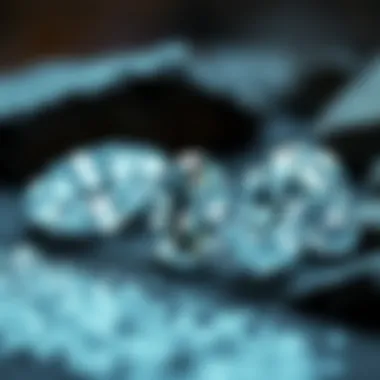
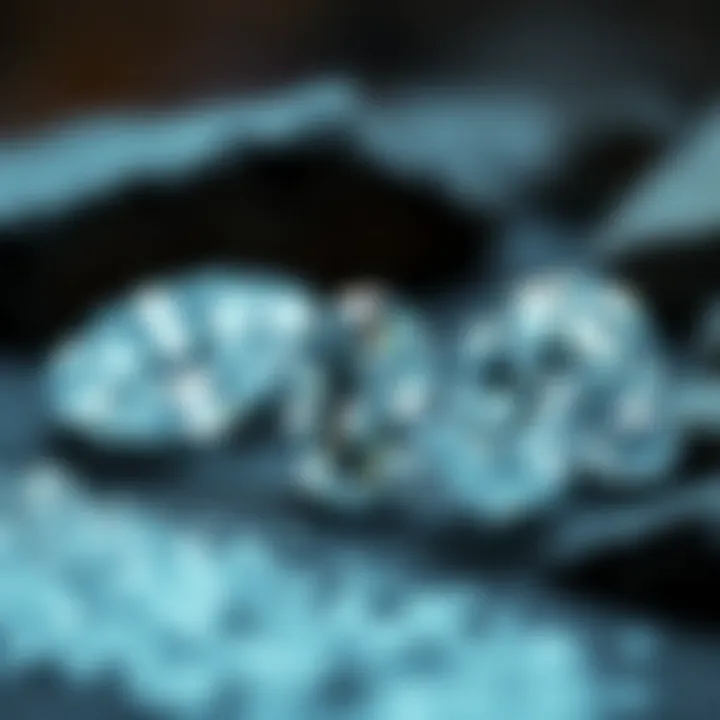
Diamonds are as much about their visual allure as they are about their physical attributes. The optical properties of diamonds contribute significantly to their desirability, and three main phenomena come into play: refraction, dispersion, and brilliance.
Refraction
Refraction refers to the bending of light as it passes through a diamond. This bending is caused by the density of the diamond, which is higher than that of air or water. A key characteristic of refraction in diamonds is its ability to create spectacular visual effects, as the light entering the stone splits into its various colors. This quality adds to the diamond’s complexity and allure. It is a preferred choice for those who appreciate how light interacts with materials. However, it does come with the downside that not all diamonds are cut optimally to enhance this effect, meaning buyers often need to be discerning in their selections. The right cut can amplify this refraction, leading to a stone that dances with light.
Dispersion
Dispersion is another captivating optical property. This is defined as the way light separates into various colors when it exits a diamond. Often described as a prism effect, dispersion ends up giving diamonds their signature fire—those colorful flashes that can dazzle onlookers. This characteristic sets diamonds apart from other gemstones, particularly in jewelry. A well-dispersed diamond can create an array of colorful sparkles, which enhances its market appeal. The trade-off? This can cause some diamonds to display a slight haziness if their cut is not appropriate. A meticulous choice by collectors noting dispersion can enhance not only appreciation but also appreciation in value.
Brilliance
Brilliance pertains to the brightness a diamond exhibits when light reflects off its surfaces. What’s fascinating about brilliance is that it often ties closely to the diamond’s cut, quality, and symmetry. A diamond that allows maximum light to enter and reflect outward will appear more vibrant and eye-catching. Collectors often seek diamonds not merely for their cost but for the sheer visual spectacle they provide. However, a trade-off lies with lower-quality cuts, which can muffle brilliance. A fine balance between carat weight, cut, and design makes brilliance an essential characteristic for buyers who want not just a stone but a testament of light and beauty.
"A diamond’s optical properties can define its beauty to an exceptional degree, but they also remind us of the importance of craftsmanship in the quest to find the perfect stone."
Evaluating Diamonds: The Cs
When it comes to understanding the true essence of diamonds, evaluating them through the lens of the 4 Cs is fundamental. These Cs—Cut, Color, Clarity, and Carat Weight—are the cornerstone for assessing the quality and value of a diamond. Rather than just looking superficially at these stones, a deep dive into these factors allows collectors to appreciate the fine details that make each diamond unique. Knowing how these aspects interact helps not only in making informed purchases but also in understanding the market dynamics surrounding these precious gems.
Each C represents a distinct quality that plays a pivotal role in the overall evaluation and helps articulate why one diamond may fetch a higher price than another. As the adage goes, "the devil is in the details." So, let’s break them down to unveil their significance.
Cut
The term 'Cut' refers to how a diamond is shaped and faceted. It affects not only the diamond's appearance but also its brilliance and sparkle. When we talk about cut, we are not simply discussing the shape like round, princess, or oval. Rather, this aspect encompasses the precision of the facets and angles, which collectively enhance or diminish light performance.
A well-cut diamond reflects light beautifully, illuminating that iconic sparkle. Conversely, even the most exquisite stone can fall flat if the cut is subpar. Think about a well-tailored suit—it looks sharp and polished, but an ill-fitting outfit can make even the most luxurious fabric appear drab.
Color
Color plays a significant role in evaluating a diamond, particularly in determining its value. Diamonds are graded on a color scale from D (colorless) to Z (light yellow or brown). The absence of color allows for maximum light reflection, thus enhancing brilliance. Collectors often seek out diamonds that are near-colorless, as they offer an ideal balance of value and appearance.
It’s worth noting that color grading can be subtle, and sometimes even experienced gemologists may have differing opinions. Those nuances resemble the subtle shift in shades at dusk; they require a discerning eye to appreciate their full beauty.
Clarity
Clarity refers to the presence of internal or external imperfections, known as inclusions and blemishes, respectively. Diamond clarity is graded on a scale from Flawless (F) to Included (I). These natural occurrences can affect a diamond's beauty, altering how light refracts through the stone. Just as fingerprints are unique to every individual, each diamond bears its own marks, telling a story of its journey.
While some collectors may prefer flawless stones, others find character in slight imperfections. It’s like a well-loved book; the worn pages and dog-eared corners add charm and history to a cherished tale.
Carat Weight
Lastly, carat weight indicates the size of the diamond. One carat equals 200 milligrams and is a standard measure across the industry. While larger diamonds tend to command higher prices, the relationship isn't strictly linear due to the significance of the other Cs at play. Two diamonds may weigh the same in carats, but their values can differ drastically based on their cut, color, and clarity.
In essence, carat weight gives one a basic understanding of a diamond’s size but doesn't depict the entire picture of its quality. For example, much like two sports cars of the same model could look strikingly similar but perform quite differently based on hidden features.
"A diamond is merely a lump of coal that did well under pressure." - Henry Kissinger
Understanding the 4 Cs signifies more than just measurement; it provides a framework for nurturing a deeper appreciation for diamonds. Collectors and enthusiasts alike should embrace this knowledge. Not only does it enrich the connection to these gems, but it also assists in making choices that reflect both personal taste and investment prudence. For more extensive insights, you may explore resources such as Wikipedia.
Synthetic vs Natural Diamonds
The topic of synthetic versus natural diamonds holds significant importance in the diamond industry and among collectors. As technology advances, the distinction between these two types of diamonds can often blur in the eyes of consumers. This section will delve deep into the manufacturing processes behind synthetic diamonds and the challenges associated with identifying them. As we explore these aspects, it becomes crucial for enthusiasts and collectors to arm themselves with knowledge about both types to make informed decisions.
Manufacturing Processes
Natural diamonds form over billions of years deep within the Earth’s mantle, subjected to immense heat and pressure. In contrast, synthetic diamonds, often termed lab-grown or cultured diamonds, are produced through advanced techniques aimed at replicating these natural conditions. The two primary methods are High-Pressure High-Temperature (HPHT) and Chemical Vapor Deposition (CVD).
- High-Pressure High-Temperature (HPHT): This method mimics the natural diamond formation process by recreating the intense pressure and temperature conditions. Carbon is subjected to extreme temperatures of about 1,500 degrees Celsius and pressures of 1.5 to 5 GPa, leading to the crystallization of carbon atoms into diamond. HPHT diamonds can exhibit characteristics mirroring their natural counterparts.
- Chemical Vapor Deposition (CVD): This more modern technique involves breaking down carbon-rich gases into carbon atoms, which are then deposited onto a substrate to form diamond crystals. CVD diamonds often start as a thin layer and can be cultivated over time. This method allows for more control over the diamond’s growth and quality, resulting in fewer impurities.
Both methods yield diamonds that are chemically and structurally identical to natural diamonds, yet the distinction lies in their origin, which can play a vital role in their market value and desirability.
Identifying Synthetic Diamonds
With the quality of synthetic diamonds improving, identifying them can present challenges even to seasoned collectors and gemologists. However, there are certain techniques and characteristics that can aid in distinguishing synthetic diamonds from natural ones:
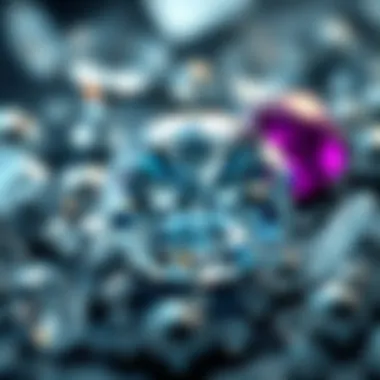
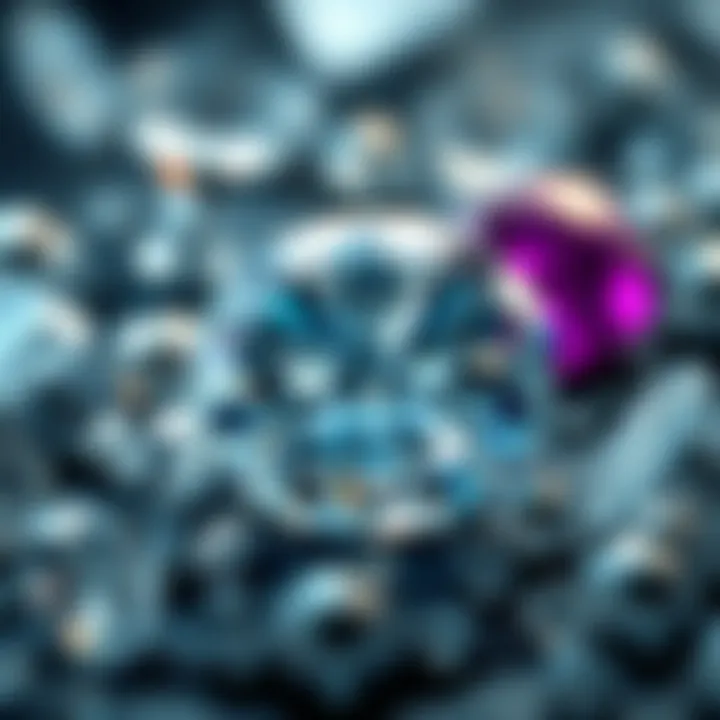
- Inclusions: Natural diamonds often contain unique inclusions called "blemishes," which have formed during their geological journey. In contrast, synthetic diamonds may showcase specific growth patterns or inclusions that are indicative of their manufacturing process.
- Fluorescence: Some synthetic diamonds can exhibit a stronger fluorescence when exposed to ultraviolet light compared to natural ones due to the presence of boron or other trace elements introduced during their creation.
- Advanced Testing: Laboratories employ various advanced tests — such as spectroscopic analysis and photoluminescence — to differentiate between natural and synthetic diamonds accurately. The Gemological Institute of America (GIA) and other organizations provide grading reports that specify whether a gem is natural or lab-grown.
Collectors should never underestimate the value of professional evaluation. Having a trustworthy report can save you from making costly errors in your collection.
Treatments and Enhancements
The allure of diamonds extends well beyond their natural beauty. In the world of gemstones, treatments and enhancements play a crucial role, shaping not only the appearance of each stone but also its overall value. Understanding these methods is key for collectors and enthusiasts alike, as these enhancements can significantly modify the perception and worth of a diamond.
When talking about treatments, we’re diving into techniques like laser drilling or high-temperature annealing—each with its own loaded implications. These changes can make a diamond appear more flawless or vibrant. Collectors should approach this knowledge as part of the journey of investing their hard-earned money into these stunning stones.
Common Treatment Methods
Diamonds, in their raw form, might not always showcase the brilliance one might expect. Hence, a range of techniques exist to enhance their natural strengths. The most common treatments include:
- Laser Drilling: A technique used to remove inclusions and blemishes. The process involves using a laser to create a narrow tunnel that can then be cleaned out. This does transform the stone’s clarity, often making it more appealing.
- High-Temperature, High-Pressure (HTHP) Treatment: This method is designed to enhance color. By simulating natural conditions found deep within the Earth, it can alter the diamond's hue or improve zoning.
- Coating: Some diamonds may be coated with a thin layer of substance to boost color or brilliance. While this method is less permanent, it does create a stunning visual effect but can wear off with time.
- Irradiation: Diamonds are subjected to radiation to enhance or change their color. Depending on the level of exposure, gemstones can attain blues, greens, or other fancy hues, gaining uniqueness.
It's essential to highlight that while enhancements improve attractiveness, they also bring questions regarding authenticity.
Impacts on Value and Perception
The impact of treatments on the market value of diamonds is nuanced. Enhanced diamonds often command lower prices compared to their untreated counterparts. Collectors often discuss this disparity, considering not just the beauty but also the integrity of the stone.
"A diamond’s value lies not just in its cuts, but in its story—treatments often tell chapters that may dim its luster in the eyes of some collectors."
When collectors assess diamonds, they tend to be wary of treatments that could be perceived as deceptive. For instance, a laser-drilled diamond may still dazzle, but its market price may reflect the perception that it had help achieving its beauty. On the flip side, some consumers appreciate the affordability that treated stones provide, allowing for larger or visually striking pieces at a better price point.
In summary, the decision around treatments and enhancements involves not just aesthetics, but a blend of ethical considerations and market dynamics. Those who delve into collecting should keep these factors in mind, as they navigate the often murky waters of gemstone valuation. For more on the subject, visit Gemological Institute of America.
The Market for Diamonds
The diamond market is a fascinating arena, steeped in tradition yet dynamically evolving. Understanding it is crucial for anyone intrigued by these precious stones, whether for personal purchase or investment purposes. Diamonds have long been seen as symbols of luxury, love, and investment. The intricate dance of supply and demand, combined with consumer perception and economic factors, defines the landscape of the diamond industry.
Trends and Pricing Factors
In recent years, the diamond market has witnessed significant shifts in trends and pricing. The advent of synthetic diamonds, for instance, has disrupted traditional notions of value in this market. These lab-created stones are often more affordable and can command a growing share of the market.
“As the market evolves, it becomes increasingly important to distinguish between natural and synthetic diamonds, as their worth is often perceived quite differently.”
Several factors contribute to diamond pricing:
- Quality of the Stone: The 4 Cs—Cut, Color, Clarity, and Carat weight—play a vital role in valuation. A well-cut diamond that sparkles brightly can fetch significantly higher prices.
- Market Demand: Economic trends greatly affect buyers' willingness to spend on luxury items. During economic upswings, demand for engagement rings and high-end jewelry typically rises.
- Brand Influence: Certain brands like Tiffany & Co. and Cartier have established themselves as leaders in the diamond market, adding a premium to their pieces due to their brand reputation.
- Ethical Considerations: The rise of ethical sourcing has gained traction, with consumers increasingly preferring conflict-free diamonds, thus influencing purchasing decisions.
The intersection of these elements creates dynamic pricing models, challenging traditional valuations of diamonds.
Collecting and Investment Potential
For collectors and investors alike, diamonds present both opportunities and challenges. The allure of possessing a rare or high-quality stone has attracted enthusiasts to the realm of diamond collecting. However, it is essential to approach this pursuit with caution.
Here are some points to consider for those interested in diamond collection and investment:
- Rarity and Quality: Just like fine art, the rarity and quality of diamonds can significantly impact their value. Investors often look for stones that have historical significance or unique features that set them apart.
- Market Knowledge: Keeping abreast of market trends is essential. A diamond that serves as a sound investment today may not hold the same value a few years down the line, and knowing what to look for can make all the difference.
- Certification Matters: Purchases should ideally include certification from trusted entities such as the Gemological Institute of America (GIA). This documentation ensures that the quality and characteristics of the diamond are authentic, providing peace of mind for collectors.
- Long-Term View: Diamonds should be viewed as long-term investments. Unlike stocks or gold, which can fluctuate dramatically, diamonds may hold their value steadily over time, particularly rare and well-preserved specimens.
Investing in diamonds is not merely a personal endeavor; it's a nuanced decision reflecting both market knowledge and personal taste. With a well-researched approach, collectors can enrich their portfolios and initiate a fascinating journey into the world of diamonds.
The End: Appreciating Diamonds
The exploration of diamonds has led us to appreciate not only their beauty but also the intricate dynamics that set them apart. They are not just stones that adorn jewelry; they carry a legacy and significance much deeper. Understanding diamonds involves delving into their unique properties, historical context, and social implications. Therefore, embracing the essence of diamonds means acknowledging their profound influence in both personal and cultural realms.
The Value Beyond Aesthetics
When we look at diamonds, the first thing that might strike us is their visual appeal—the shimmering facets that capture and reflect light in a remarkable manner. However, what lies beneath this surface beauty is equally compelling. Diamonds represent human ingenuity and the quest for perfection. Their hardness signifies durability, not only literally, but symbolically. They’re often associated with everlasting love and commitment. The value of a diamond transcends its price tag; it's about the stories it tells.
- Cultural Significance: In many societies, they are intertwined with cultural practices, often used in rituals and celebrations, making them much more than just decorative items.
- Investment Potential: Beyond their emotional connection, diamonds have also emerged as a sound investment, with certain types appreciating over time. Investors often weigh diamonds’ potential in diversifying portfolios.
"Diamonds are not just a symbol of wealth; they are a testament to personal milestones and societal evolution."
Future of Diamonds in Society
As we stand at the crossroads of tradition and innovation, the future of diamonds seems bright yet complex. On one hand, the market for synthetic diamonds is expanding rapidly, presenting an ethical and sustainability argument. These lab-grown variants offer a more environmentally friendly option and are becoming increasingly accepted in mainstream jewelry.
- Sustainability Concerns: As awareness around ethical sourcing intensifies, consumers prefer diamonds that do not exploit labor or deplete natural resources. This trend influences both market preferences and production methods.
- Technological Advances: The emergence of advanced manufacturing technologies is likely to reshape our understanding of these gems. Creating cheaper, high-quality diamonds in laboratories could disrupt traditional diamond mining practices, potentially affecting how diamonds are perceived and valued.
As collectors and enthusiasts, it’s paramount to remain aware of these changes. Understanding the future landscape of diamonds helps in making informed choices, whether one is buying a piece of jewelry or considering a purchase as an investment. By appreciating both the heritage and the evolving narrative of diamonds, we can better understand their role in our culture and economy.



